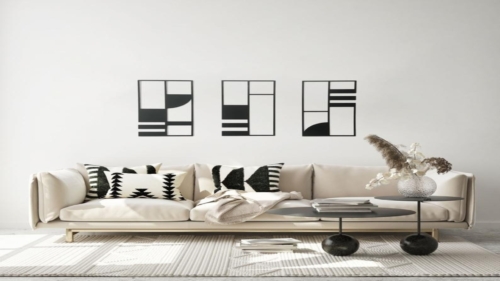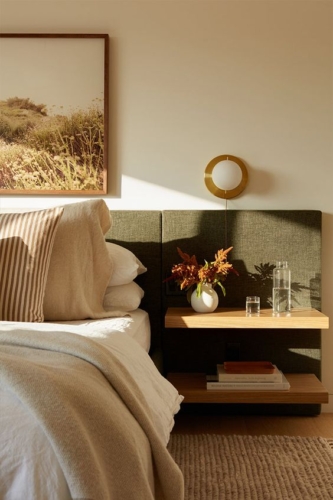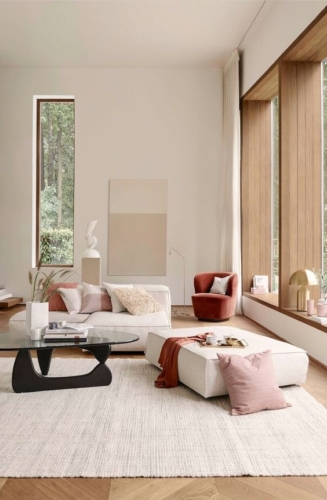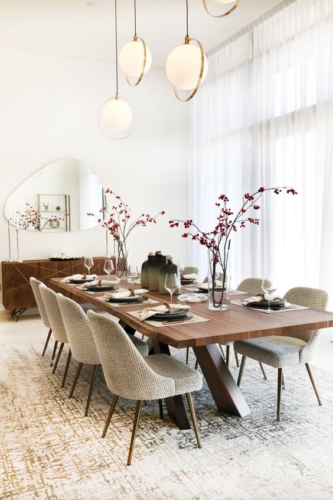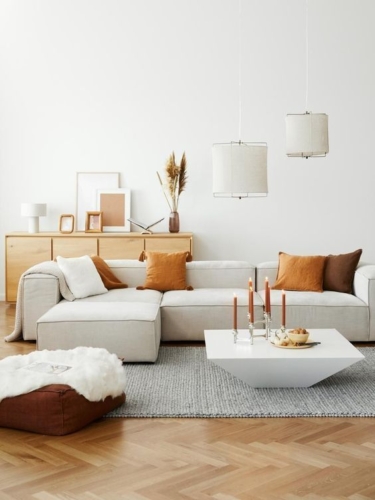Contrary to popular belief, minimalist interior design is not solely about living with as little as possible. This design approach has evolved to encompass a global concept that transcends cultural boundaries, as Niya Bascom, the creative director at Ishka Designs, a full-service interior design firm in Brooklyn, emphasizes.
Minimalism goes beyond the image of a clutter-free room with monochromatic tones and minimal furnishings. It’s a philosophy that extends far beyond the surface aesthetic, with cultural nuances shaping its interpretation in diverse spaces. In this comprehensive guide, gain insight into the world of minimalist interior design, exploring its historical roots, core elements, and strategies to infuse it into your living space.
Understanding Minimalist Interior Design
When discussing minimalist homes, the common image that emerges features rooms devoid of clutter, white walls, and a scarcity of decorative items. This design is often associated with Scandinavian and Japanese interiors, both of which embrace a “less is more” ideology. Minimalist spaces are typically characterized by clean lines, restrained ornamentation, a neutral color palette, and the use of natural materials. However, this initial impression merely scratches the surface of what minimalist design truly entails.
“Minimalism doesn’t exclusively belong to specific cultures such as the Japanese or Scandinavians,” Anishka Clarke, interior design director at Ishka Design, asserts. The minimalist lifestyle can also be observed in nomadic communities, such as the Wodaabe people, where practical necessity drives minimalistic choices. For instance, the Wodaabe’s habit of frequently relocating, carrying all their belongings with them, reflects a minimalist and pragmatic mindset.
This example underscores a fundamental aspect of minimalist design—it’s not just an aesthetic but a way of life. Minimalism encourages conscious consumption and advocates for living with only what’s essential. While Western interpretations often focus on monochromatic and uncluttered aesthetics, the essence of minimalism extends far beyond these visual parameters.
Expanding the Definition
Contrary to preconceived notions, minimalism doesn’t require eschewing color. A case in point is an Ishka Designs creation that incorporates color while adhering to minimalist principles. Annette Frommer, an interior designer, highlights the value of personal items in a minimalist setting. This approach emphasizes keeping possessions that hold genuine sentimental or functional importance, rather than conforming to a particular look.
Moreover, functionality plays a pivotal role in minimalism. It entails thoughtful storage solutions and designs that serve a purpose beyond mere aesthetics. This functionality fosters an uncluttered environment while providing practical benefits.
A Historical Perspective on Minimalism
Minimalism’s origins are rooted in the minimalist art movement that gained prominence after World War II. Artists like Frank Stella, Donald Judd, and Agnes Martin laid the foundation for this movement. As art embraced minimalism, its core principles infiltrated design and architecture, gaining popularity in the 1980s. The minimalist approach responded to the chaos of urban life, stripping structures to their essential elements. Notably, this aesthetic can be traced back to midcentury-modern and international movements, exemplified by visionaries like Ludwig Mies van der Rohe, who famously championed the phrase “less is more.”
The Enduring Appeal of Minimalism
Despite its historical roots, minimalist design continues to captivate the imagination of enthusiasts. An intrinsic link to sustainability underpins its lasting allure. In an era marked by impending environmental crises, minimalism aligns with reduced consumption and a return to essentials. People are increasingly questioning whether they should acquire more, emphasizing the ethical imperative to minimize one’s ecological footprint. This ethos resonates deeply with the core principles of minimalism.
Moreover, minimalist design counters excessiveness. Traditional styles like Rococo and Gaudí are known for opulence and ornamentation. However, minimalism represents a divergence from such ostentation, attracting those who seek an understated elegance that focuses on essentials. By embracing this aesthetic, individuals celebrate the beauty of simplicity without the compulsion to showcase their possessions.
Principles of Minimalist Design
When entering a minimalist space, the absence of excess becomes palpable. The design appears meticulously curated, with each element serving a purpose. This underscores one of the fundamental principles of minimalist design: a focus on essentials while eschewing extraneous additions. Such a space exudes tranquility and offers the eye a place to rest.
A purpose-driven mindset defines minimalist design. Rather than asking, “How little can I live with?” the question becomes, “What can I eliminate without compromising functionality?” Designers like Bascom and Clarke strive to identify their clients’ genuine preferences, eliminating superfluous elements to emphasize what truly resonates.
This interpretation underscores that minimalism doesn’t adhere to a single style. While common manifestations involve uncluttered, white-walled rooms with sparse furnishings, it’s essential to realize that minimalism’s essence transcends appearances. An individual’s identity and heritage can be harmoniously integrated within a minimalist framework. This flexibility allows for diverse expressions of the movement while maintaining its core principles of tranquility, purposefulness, and uncluttered aesthetics.
Examples of Minimalist Interior Design
For practical examples of minimalist interior design, consider the designs presented. These designs span various living spaces, showcasing the adaptability of minimalist principles.
From serene living rooms to understated dining areas, these spaces epitomize the elegance and functionality of minimalist design.
Embracing Minimalism in Your Home
To incorporate minimalist principles into your home, heed advice from experts like Clarke and Bascom. Decluttering takes center stage, especially in smaller spaces. Minimalist design thrives when unburdened by unnecessary possessions. Bascom recommends retaining items of personal significance rather than conforming to a prescribed aesthetic. This practice maintains the authenticity of your living space.
When introducing new items, gravitate towards timeless, classic, and simple pieces. This strategy ensures the longevity of your design, eschewing the need for constant updates. Clarke encourages an intentional mindset. Your home need not mimic Pinterest images; the focus is on the intention and ambiance created. Designing a minimalist space demands patience—building a harmonious environment takes time and careful consideration.
Ultimately, trust your instincts and taste. Clarke advises against succumbing to external pressures; your home is a reflection of your individuality. Bascom emphasizes that nobody else resides there, highlighting the importance of prioritizing your preferences.
In the realm of minimalist lighting design, brands like OVUUD epitomize the intersection of minimalist aesthetics, natural materials, and cutting-edge lighting technology. These products align with the core tenets of minimalist design.
Minimalist interior design transcends the notion of stark simplicity. It embodies a philosophy that celebrates essentials, encourages purposeful living, and embraces tranquility. From its historical evolution rooted in art movements to its enduring appeal in a world focused on sustainability, minimalist design speaks to the essence of what truly matters in our living spaces. Whether expressed through monochromatic palettes or vibrant hues, minimalist design provides a canvas on which individuals can create spaces that resonate with their true selves.
Check out 10 Stunning LA and OC Minimalist Homes to Inspire You for more additional inspiration.
About Us:
Founded in 2017, Satin and Slate is one of the elite interior design studios in Southern California. Located in Long Beach, this dedicated team of designers oversees from kitchen and bathroom renovations to commercial projects. Equipped with their own showroom/studio they can satisfy the needs of any client. Featuring clean lines, bright colors and fresh ideas Satin and Slate’s mission is to bring your vision to life and help transform your space into something extraordinary.


